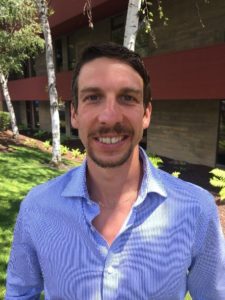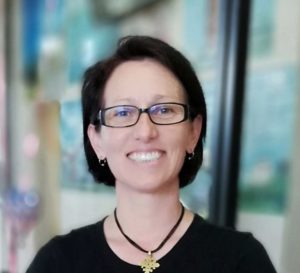An Interview with Our Alumna Raven P. Moret, MS ’21

June 2022
- Where do you currently work and what are your job responsibilities?
I am currently entering into my second year at the Center for Disease Control based in Atlanta, GA. I am serving as a biostatistician and assist on studies to be published in peer-reviewed journals examining provider practice with respect to various diseases. Additionally I am developing protocols for power analysis and sample size within my division as well as course modules for incoming fellows.
- Why did you choose to study biostatistics and what led you to LSUHSC Biostatistics Program?
After seven years of research I came to enjoy the analytical process of the studies I was conducting. I felt that being able to put my findings into descriptive form to show and explain was very fulfilling after all of my hard work. As a New Orleans native I wanted to stay close to home and was aware of the strong work done at LSUHSC from many of the presentations at the Louisiana Cancer Center Scientific Retreats. I knew I’d be in good hands.
- What was the most rewarding part of your MS degree?
The most rewarding part of this degree was being able to expand my knowledge from an analytical perspective. The instructors were amazing at providing so many ways to approach and view problems. Also, the technical skillsets I learned through the program, the different software and applications, opened up countless opportunities for me both career and growth wise. Returning to school after so many years was a very intimidating choice but I couldn’t be happier with my decision.
An Interview with Our Alumnus Jacob Maronge, MS ’16

December 2019
- Where do you currently study and what are your goals after graduating?
I am currently a PhD candidate in biostatistics, which is a specialization within the statistics PhD jointly offered between the departments of statistics and biostatistics at the University of Wisconsin-Madison. I work with Professor Paul Rathouz on outcome-dependent sampling (ODS); the core concept of ODS is how to perform correct estimation and inference when sampling is performed based on observed values of a response, instead of a predictor. Specifically, we are thinking about how to generalize the notion of case-control, studies, which are popular in epidemiology, to non-binary outcomes. We refer to these types of studies as “generalized case-control studies”. My dissertation research revolves around how to design and analyze these types of studies.
During my time at LSUHSC I worked with Professor Zhide Fang on optimal experimental design. The work during my MS was a bit different because it was focused on design using covariates, not outcomes. However, it was particularly useful because I think it gave me a strong understanding of important design concepts.
After graduating, I would like to join a biostatistics department where I can continue to work in biomedical research. My goal is to be a clinical biostatistician and continue to develop methods and useful tools for practitioners.
- Why did you choose to study biostatistics and what led you to LSUHSC Biostatistics Program?
During my undergraduate degree, I studied both biology and physics. I have always been interested in biology and medicine, but probably had more natural talent in mathematics. Biostatistics gives me the opportunity to use mathematics in a way that feels like it has a more immediate impact. I chose LSUHSC for personal reasons, but it ended up being the perfect place for me at the time.
- What was the most rewarding part of your MS degree?
My time at LSUHSC was one of the most influential times of my education. The professors I had during my MS still have a huge impact on how I think about statistics now. It was great to be in a place where I felt like I was receiving quality, individualized education. I still keep in touch with many of my instructors from LSUHSC, which is a testament to the effort they put into their students.
The most rewarding part was when I came to Wisconsin, I immediately felt prepared for the coursework and other challenges. Had I not attended LSUHSC, I think I would have struggled much more.
An Interview with Our Alumnus Ondrej Blaha, PhD ’19
 June 2019
June 2019
- Where do you currently work and what are your job responsibilities?
Currently, I work as a Senior Biostatistician at Stanford University, School of Medicine. I am responsible for running clinical studies under an umbrella of projects that span University’s Pediatric Heart Center, Hospital Medicine, Behavioral and Developmental Studies, and a triplet of concussion studies. A joint effort of University’s departments of neurology, neurosurgery, engineering, center for clinical research, NIH, and PAC-12 are looking into the long-term effects of concussive and sub-concussive impacts on athletes’ brain structure using an in-house developed, censors embedded mouth-guard and in-house developed AI software for evaluating individual events. Currently, my work is mostly in clinical trials and bio-medical sciences in general. I work on everything that is a part of being a senior biostatistician: design of experiments, grant writing, programming, statistical analysis, manuscript writing and editing, etc. That is the fun stuff. I work on developing statistical methodologies as well. I am also responsible for leading and training junior statisticians and preparing training sessions for statistical beginners.
- Why did you choose to study biostatistics and what led you to LSUHSC Biostatistics Program?
Biostatistics is a marriage between my two most favorite disciplines; mathematics and biology. I could never decide which one I liked better. I loved medicine and biology but always knew that I can influence more and save much more lives through mathematics. It is not an accident that mathematics is called the “queen of the sciences”. However, I missed being in touch with biology throughout my initial years as a mathematician. When I eventually learned about the existence of biostatistics it was clear what career I have to pursue. I learned about the LSUHSC Biostatistics program when Dr. Volaufova was on sabbatical at my Alma Matter in my home country, so you can say it was her who led me there.
- What was the most rewarding part of your PhD degree?
Of receiving my PhD or working towards it? The best part of receiving the degree was the first paycheck. And the knowledge that I now have my dream job and things will only get better from here. About working towards my degree, it was working with my mentors. Learning about new, unexplored areas of statistics, how to conduct theoretical research, be independent, and also making my program work. You know, the feeling when the program finally runs as intendedJ. LSUHSC has that unique one-on-one approach you can hardly get anywhere else. You can be sure that you will get enough attention and you can always ask questions outside the scope of the classwork. Faculty members were extremely helpful and were always there when I needed them the most. LSUHSC also has unmatched opportunities for collaboration that are readily available. You can work alongside distinguished researchers on various projects of your interest. There is a huge demand and not enough hands to do all the work. It is only up to you if you pick up the call. In the end, these opportunities are what eventually helped me land the best job in the world.
An Interview with Our Alumna Jennifer Hayden, MS ’11
 May 2019
May 2019
- Where do you currently work and what are your job responsibilities?
I am a senior research scientist with Humana Healthcare Research. My primary responsibility is to design scientifically valid healthcare studies to answer research questions around clinical and economic trends. Using large ‘real world’ healthcare data sources I develop measures, produce statistical output and interpret and report study results through presentations, abstracts and publications.
- Why did you choose to study biostatistics and what led you to LSUHSC Biostatistics Program?
By the time I enrolled into the LSUHSC Biostatistics Program I had already enjoyed a long career in healthcare data management which included database development, data maintenance and data monitoring but, I did not have training or skills in statistical data inference. I love working with healthcare data and I knew I wanted to do more with it and could apply the programming skills I already had to a biostatistics degree. I was working in a different department at the LSUHSC School of Public Health when I applied for the program and knew I would get an excellent statistics education from LSUHSC. I personally knew the faculty as colleagues. They are excellent statisticians, well published, and dedicated to helping each of their students succeed; even older and non-traditional students like me.
- What was the most rewarding part of your MS degree?
Designing and programming the research question which became my Master’s thesis was for me the best future job training I received from the MS program. The faculty challenged me to not be afraid to think independently and I apply these skills daily to develop well designed study protocols which I then translate into SAS code. I really love the work I do and am myself now published in a variety of journals and conferences. The LSUHSC Biostatistics Program changed my life and opened up so many opportunities I would not otherwise have had. I work from home, right here in New Orleans, on huge datasets with hundreds of thousands of observations doing exactly what I envisioned doing all those years ago.
An Interview with Our Alumna Angela Stodghill, PhD ’15
 April 2019
April 2019
- Where do you currently work and what are your job responsibilities?
I am a contracted senior statistician for Janssen Pharmaceuticals. My main job duties are designing and planning clinical trials as well as analyzing clinical trial data. In addition, I am working on improving statistical methods used in clinical trials.
- Why did you choose to study biostatistics and what led you to LSUHSC Biostatistics Program?
Growing up, my parents worked in the medical and pharmaceutical fields. I was planning to be a doctor or a pharmacist. However, I also loved computer programming. More importantly, numbers and the way data can help people in their lives fascinates me. In college, one of my math professors, a statistician working in the pharmaceutical industry, introduced me to the drug development process and the important role a statistician plays in a clinical trial. Therefore, getting a PhD in biostatistics was a no brainer for me. I chose LSUHSC because LSU is a great college to be a part of, and it has spent a huge amount of funding on medical research. In addition, the biostatistics program provides very attractive stipends for PhD students and a lower cost of tuition compared to other state funded schools.
- What was the most rewarding part of your PhD degree?
During my dissertation process, I learned how to think, research, and solve problems independently. In addition, I learned how to write formally and logically to demonstrate my way of thinking. All these skills help me still in my daily work. Also, the course material that you learn is what will be used in your future job. During my past 4 years of work, I used a majority of the statistical methods I learned in my courses. Most importantly, I am using SAS to do my daily job which I learned mostly as a PhD student.
